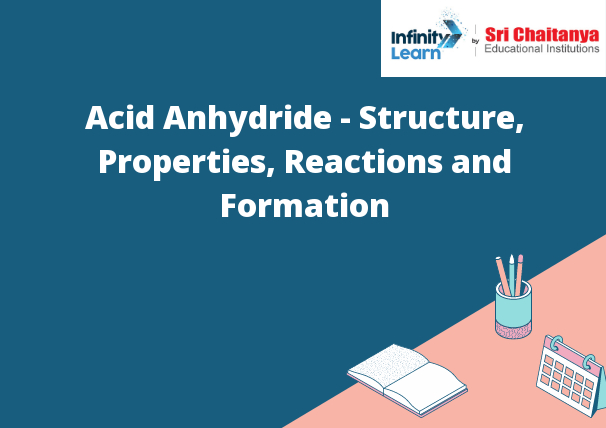Table of Contents
Acid Anhydride
Acid Anhydride – Structure: An acid anhydride is a compound that results from the dehydration of an acid. The anhydride has the same functional group as the acid, but the hydrogen atoms have been replaced by oxygen atoms.
Acid anhydrides are generally unstable, and they tend to form acids and water when they come in contact with water. They are often used as intermediates in the synthesis of other compounds.

What is an Acid Anhydride?
An acid anhydride is a chemical compound formed when two acid molecules combine with the elimination of a water molecule. It is a reaction between two acids, where the hydroxyl group of one is replaced by the other acid’s hydroxyl group. Acid anhydrides are generally strong acids, and are often used as reagents in organic chemistry.
Acid Anhydride Structure
An acid anhydride is a compound that results from the combination of an acid and an oxide. The acid anhydride structure is formed when the oxygen atom in the oxide combines with the hydrogen atom in the acid to form water. This leaves the acid molecule with two fewer hydrogen atoms and the oxide molecule with one less oxygen atom.
The acid anhydride molecule has the general formula of AXO. An acid anhydride is a molecule that contains at least one oxygen atom that is double-bonded to another atom. This atom is typically carbon. The presence of the oxygen atom causes the molecule to be acidic. The double-bonded oxygen atom makes the molecule more reactive, which allows it to participate in chemical reactions more easily.
Reactions of Acid Anhydrides
Acid anhydrides are chemical compounds that are formed by removing a water molecule from two acid molecules. They are highly reactive and can undergo a wide range of chemical reactions, some of which are discussed below.
1. Reaction with Water: Acid anhydrides react vigorously with water to form corresponding carboxylic acids. This reaction is known as hydrolysis. The reaction is exothermic and can sometimes produce heat that is enough to boil the water.
For example, when acetic anhydride is mixed with water, it forms acetic acid:
(C2H3O)2O + H2O → 2CH3COOH
2. Reaction with Alcohols: Acid anhydrides can react with alcohols to form esters. This reaction is known as esterification. The reaction is catalyzed by acids such as sulfuric acid and hydrochloric acid.
For example, acetic anhydride reacts with methanol to form methyl acetate:
(C2H3O)2O + CH3OH → CH3COOCH3 + CH3COOH
3. Reaction with Amines: Acid anhydrides can also react with amines to form amides. This reaction is known as amidation. The reaction is catalyzed by acids such as hydrochloric acid and sulfuric acid.
For example, acetic anhydride reacts with ammonia to form acetamide:
(C2H3O)2O + NH3 → CH3CONH2 + CH3COOH
4. Reaction with Acids: Acid anhydrides can react with other acids to form more complex compounds. This reaction is known as acid anhydride exchange.
For example, acetic anhydride reacts with acetic acid to form acetic anhydride and acetic acid:
(C2H3O)2O + CH3COOH → (CH3CO)3O
5. Reaction with Bases: Acid anhydrides react with bases to form salts known as carboxylates. This reaction is known as carboxylation.
For example, acetic anhydride reacts with sodium hydroxide to form sodium acetate:
(C2H3O)2O + 2NaOH → 2CH3COONa + H2O
Formation of Carbonic Acid
An acid anhydride is a chemical compound that is formed by the removal of a water molecule from two acid molecules. The process of formation of acid anhydrides is an important concept in organic chemistry, and it is important to understand the factors that influence this process.
- Condensation of Two Carboxylic Acids: The most common method for the formation of acid anhydrides is the condensation of two carboxylic acids. This reaction is catalyzed by strong acids, such as sulfuric acid and phosphoric acid. During this reaction, a water molecule is removed from two carboxylic acids, and an acid anhydride is formed.
For example, the condensation of two molecules of acetic acid produces acetic anhydride:
2CH3COOH → (CH3CO)2O + H2O
- Reaction of Carboxylic Acids with Acid Chlorides: Another method for the formation of acid anhydrides is the reaction of carboxylic acids with acid chlorides. In this reaction, an acid chloride reacts with a carboxylic acid, and a water molecule is eliminated to form an acid anhydride.
For example, the reaction between acetic acid and acetyl chloride produces acetic anhydride:
CH3COOH + CH3COCl → (CH3CO)2O + HCl
- Reaction of Carboxylic Acids with Acid Anhydrides: Acid anhydrides can also be used to form other acid anhydrides through a reaction known as acid anhydride exchange. In this reaction, an acid anhydride reacts with a carboxylic acid to form a new acid anhydride and a carboxylic acid.
For example, the reaction between acetic acid and acetic anhydride produces acetic anhydride and acetic acid:
(CH3CO)2O + CH3COOH → (CH3CO)3O
In conclusion, acid anhydrides are important chemical compounds that can be synthesized by different methods, including the condensation of two carboxylic acids, the reaction of carboxylic acids with acid chlorides, and the acid anhydride exchange reaction. Understanding the mechanisms behind the formation of acid anhydrides is crucial for developing new and efficient synthetic strategies in organic chemistry.
Naming Acid Anhydrides
An acid anhydride is a molecule that contains two oxygen atoms bonded to a single central atom. The acid anhydride is named by taking the name of the acid and replacing the “ic” ending with “ide.”
Nomenclature of Acid Anhydride
Structural Formula:
R-C=O-O-R
IUPAC Name:
carboxylic acid anhydride








